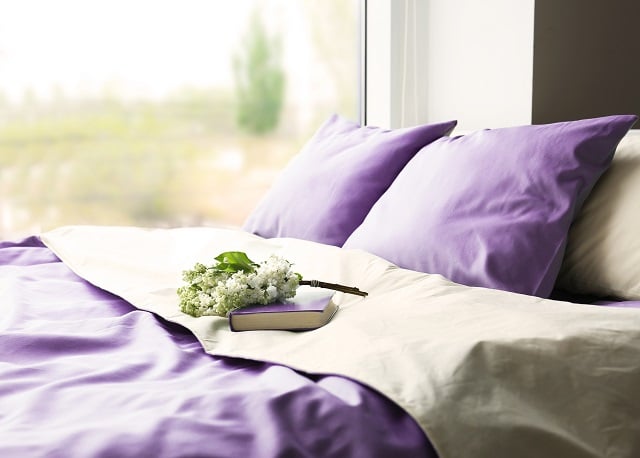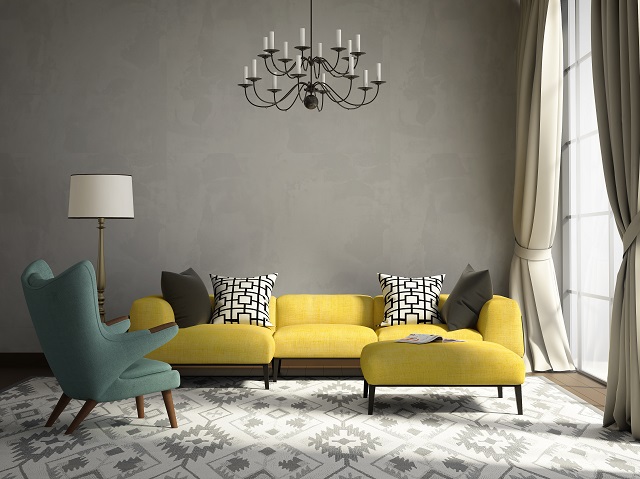
Color theory involves the study of hues and how to use them in harmony. It’s helpful in design because it informs a palette that work well together. These choices play a key role in the overall environment of a home because color can influence moods, feelings and even increase how much sleep you get. You can design your home by selecting furnishings and fabrics in hues that suit your personality, too.
A Quick History of Color Theory
The principles of color theory date back farther than Leonardo da Vinci. The color wheel that resulted a few centuries later, displays the primary, secondary, and tertiary hues.
- Primary hues are red, yellow, and blue.
- Secondary are mixtures of primary colors, namely green, orange, and purple.
- Tertiary are the result of mixing one primary and one secondary color.
Choosing Paint Colors
Although a house has separate rooms, each area should flow easily and seamlessly into the others to create a cohesive decorating scheme. If rooms showcase starkly different palettes or decorating styles, the overall impact can be unsettling and abrupt. Instead, colors, fabrics, patterns, and objects should have a calming balance that feels natural and connected.
Some homeowners opt to use one paint color on all walls of connected spaces. This is especially ideal for homes that have open floor plans.
Homeowners who prefer a bit of variety might apply colors to walls based on sight lines from one room to the next. Visual connections between rooms have the pleasing effect of a color scheme.

Find a Harmony
The relationship hues have with one another on the color wheel can be used to find interesting pairs or combinations. These are harmonies and there are six popular types:
- Monochromatic – a single color broken out into different values
- Analogous – a small group of colors that neighbor each other on the wheel
- Complementary– two hues that sit directly opposite on the wheel
- Split-complementary – a trio where one sits opposite two hues that neighbor its complement
- Triadic – three colors that are equidistant from one another on the color wheel
- Tetradic (Double-complementary) – 2 pairs of complementary colors
You may need examples to visualize harmonies in interior design and find the one that inspires you most.
Pick a Temperature Palette
Most hues fall into one of two temperatures, often called tones (even though “tone” technically refers to the amount of gray in a hue):
- Warm: red, pink, orange and yellow
- Cool: blue, indigo, purple and green
Blending different temperatures can result in rich, versatile hues like chartreuse or plum.
A quick way to build an attractive theme is to choose a warm or a cool palette, varying colors only within this scheme. For example, if you choose cool tones, you can paint your walls with a soft, light blue and paint the trim gray or white. A warm palette might have diffused, peach walls and ivory or eggshell trim.
Neutral paints can mix and match with warm or cool accents. Neutral hues, like beige or taupe have undertones, like yellow, pink or blue, so choosing one with an undertone that matches or contrasts with other elements will affect the design.
These undertones have spatial effects on a space. Warm hues can make surfaces feel closer, cozier. Cool tones can create the illusion of space.
Meaning & Characteristics
Part of color theory in interior, and graphic, design are the imposed characteristics that people often associate with a hue. Some hypothesize that this color-personality relationship stems from synesthetic expression. Whatever the origin for the association, designers carefully choose their palettes for the impression they impart on the viewer.
- Red: ambitious, bold, powerful, passionate, active
- Orange: instinctive, optimistic, extroverted, charismatic
- Yellow: energetic, joyous, friendly, spontaneous, fun
- Green: growth, prosperous, hopeful, restorative, generous
- Blue: content, responsible, intelligent, authoritative, controlled
- Purple: creative, fanciful, distinguished, compassionate, devoted
The value, lightness or darkness, of the hue can enhance or lift these characteristics even more. Consider the traits of black if you opt for a darker scheme and white if you’re looking to brighten the space.
- Black: confident, elegant, mysterious, commanding, judicious
- White: wise, pure, honest, innocent, influential
Colors can convey these characteristics and blend with your senses to leave you feeling synergized with them. The saturation and scheme of a home can boost mood and provide a form of color therapy in any room.

Balancing Your Palette
It can be easy to get carried away when you find a hue you love. The best way to make sure that you use your palette in attractive way is to create a careful balance. A commonly used ratio is 60:30:10.
Choose one color as the dominant to fill about 60% of the space. Most designers choose a neutral as their dominant hue. Then, select a secondary and accent hue(s). A secondary color should fill about 30% of the room while accents take about 10%.
As seen in the image above, a neutral hue is used on the walls, which take up most of the room’s surface area. A secondary color, a clean white or cream, takes up about 30% of the space when used on the rug, lamp shade, and pillows. Accents, in this case yellow and teal and a deep grey or black, only take up about 10 percent of the whole picture as the furnishings.
Accent with Light and Texture
Color palettes play a pivotal role in the overall decorating scheme, but there are other important considerations as well.
Light is one of the best ways to highlight and adjust stylistic uses of color, giving it more depth and value. Installing light dimmers is also an effective way to calm the atmosphere. It’s important to experiment a little to find the right fit. Because applying paint can be easy and low paint costs, so if one color on a wall doesn’t feel quite right, it’s alright to repaint with another.
Textures and fabrics will be an integral part of a room’s decor. Wooden or stone surfaces, window treatments, furniture upholstery, flooring and accents such as throw blankets and pillows will add textures to enhance the comfort and feel of a room. A room can be dressed up or down to give it a formal or informal feel, creating a chic interior or lived-in look.
Or, Hire a Designer or Decorator
Whether you’re new to color theory in interior design or not, talking to a local decorator can be informative and inspiring. Find interior designers with the experience and expert knowledge to bring all the benefits of color to your space.
 Add Custom Beauty to Your Home with Blown Glass
Add Custom Beauty to Your Home with Blown Glass  The Dish on Dining Room Decorating
The Dish on Dining Room Decorating  Focus Factors: Hanging Framed Art and Picture Lighting
Focus Factors: Hanging Framed Art and Picture Lighting  Enhance Home Design with Decorative Leaded Glass
Enhance Home Design with Decorative Leaded Glass  The 5 Benefits of Working With an Interior Designer
The 5 Benefits of Working With an Interior Designer 

Are You Familiar With This Topic? Share Your Experience.